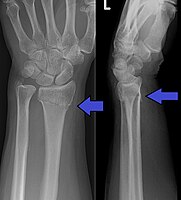
Photo from wikipedia
Introduction Complex intraarticular distal radius fractures are common, and treatment with open reduction and internal fixation (ORIF) can be done through either the palmar or dorsal approach. There is scant… Click to show full abstract
Introduction Complex intraarticular distal radius fractures are common, and treatment with open reduction and internal fixation (ORIF) can be done through either the palmar or dorsal approach. There is scant evidence, however, indicating which approach is more suitable. We compared clinical and radiological outcomes of patients with AO 2R3 C3 fractures surgically treated with one of these approaches. Materials and methods From January 2015 to November 2018, 72 surgically treated patients with AO 2R3 C3 fractures were radiologically (12 months) and clinically (mean 26 months) evaluated. Forty-one patients underwent ORIF using the palmar approach (Group 1), and the dorsal approach was used in 31 patients (Group 2). Radiological parameters were measured using the AO scoring system immediately following surgery and 12 months later. Clinical assessments included the range of motion, PRWE and DASH scores. Results At the immediate postoperative assessment, the median AO score was 5.5 (IQR 2–9.5, range 0–30.5) for Group 1 and 8 (IQR 5–15, range 0–27) for Group 2, and 12-month follow-up results were 4.5 (IQR 1.5–10, range 0–41) and 6.5 (IQR 5–11, range 0–29.5), respectively. Group 1 had more favorable results for the flexion, extension, radial abduction, PRWE and DASH parameters. The plate removal and reoperation rates were higher in Group 2. Discussion When treating complex intraarticular distal radius fractures, we found the palmar approach was more advantageous for this fracture pattern. Nevertheless, a dorsal approach may still be suitable for intraarticular comminuted distal radius fractures with dorsally displaced joint fragments.
Journal Title: European Journal of Trauma and Emergency Surgery
Year Published: 2020
Link to full text (if available)
Share on Social Media: Sign Up to like & get
recommendations!